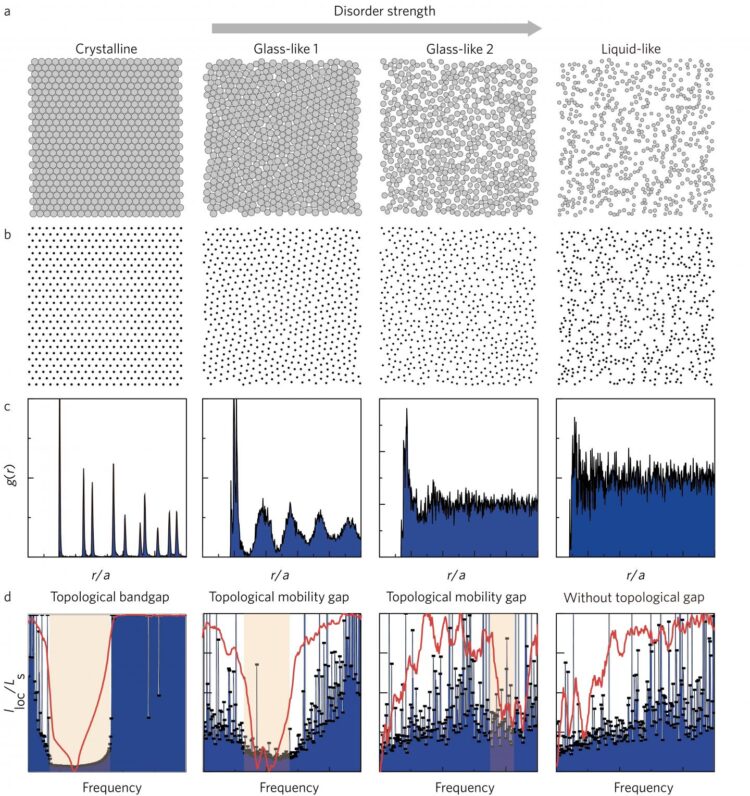
Credit: by Peiheng Zhou, Xin Ren, Yihao Yang, Haoran Xue, Lei Bi, Longjiang Deng, Yidong Chong, and Baile Zhang
The paradigm-shifting concept of topology has not only revolutionized condensed matter physics, but has also opened a fundamentally new chapter in photonics, mechanics, acoustics, and many other fields. In photonics, “photonic topological insulators” (PTIs), the photonic analogs of electronic topological insulators, have enabled unprecedented exciting photonic functionalities such as one-way robust photonic transport and topological lasers.
These topological systems, whether based on condensed matter or photonics, typically derive their topological properties from bandstructures based on periodic lattices. On the other hand, photonic amorphous phases without periodic atomic lattices widely exists in nature (e.g., glass, polymer, and gel). The properties of these amorphous systems are determined by the short-range connectivity of their atoms/molecules, rather than the long-range periodicity.
In a new paper published in Light Science & Application, a team of scientists, led by Professor Peiheng Zhou / Professor Longjiang Deng from University of Electronic Science and Technology of China, Professor Yidong Chong and Professor Baile Zhang from Nanyang Technological University have experimentally realized amorphous PTIs that are non-crystalline variants of a Chern-number-based PTI. Their study demonstrates the interesting interplay between topology and short-range order, especially during the glass transition. Chern-number-based PTIs are the first type of PTI ever realized. Their work is the first to study amorphous PTIs using this type of photonic structure. They also find that the extinction of photonic topological edge states refers to the glass transition. These insights may be useful for realizing amorphous topological insulators in other physical settings such as acoustics.
The amorphous PTI consists of gyromagnetic rods that are arranged in computer-generated amorphous lattice patterns, and magnetically biased to break time-reversal symmetry. By performing edge/bulk transmission and near-field distribution measurements to the PTIs in a copper parallel-plate waveguide, the existence of robust topological edge states in the amorphous PTIs are experimentally verified prior to the onset of the glass transition. By further deforming the amorphous lattice into a liquid-like lattice, the closing of the mobility gap and the disappearance of the topological edge states are observed. These scientists summarize the features of their topological system:
“We design an amorphous PTI system with three advantages: (1) the amorphous lattices are realizable in natural materials as they are generated by Molecular Dynamics Methods; (2) the full mapping from crystalline to glass-like amorphous to liquid-like phases yields the whole evaluation of the topology, from emergence to extinction, and clearly captures the role of the glass-liquid transition; and (3) the photonic platform can be immigrated to verify other non-periodic photonic topological materials.”
“The topological protection supported by the short-range order in our amorphous PTIs persists remarkable robustness to large defects, e.g. 3 times the characteristic length of the lattices, and 90º bends, all comparable to the crystalline counterparts” they added.
“The presented approach can be used to develop specific amorphous PTIs with desired structural correlations, e. g. the hyperuniform structures studied in bandgap photonic crystals, or monitor other non-periodic PTIs, e.g. the quasi-crystals or metamaterials. Our findings will therefore be highly useful for future works investigating non-crystalline topological photonic materials for novel photonic devices, such as topological random lasers.” the scientists forecast.
###
Media Contact
Baile Zhang
[email protected]
Related Journal Article
http://dx.





